This article is part of the data analysis series focusing on Team GBs women’s soccer Tokyo 2020 Olympic roster. Considering the recent announcement and postponement of this summer’s Olympic Games, and although no competitive games this summer will occur in Tokyo, the analysis of players for a potential Tokyo 2020, if the games would have occurred will proceed.
Utilising comparisons of key metrics, 18 total players will be identified for consideration and subsequent selection within Phil Neville’s group. Each article will be split into position-specific groups, and alongside Abdullah Abdullah, the wide forwards and central defenders have been completed previously. This article will look at the data on the wide defender positional players in order to provide an objective analysis and scout report on each player.
To recap, Team GB women’s soccer head coach, by analyzing the England women’s team and the tactics implemented previously, would likely have utilized a 1-4-4-2 (1-4-4-1-1) or 1-4-3-3 (1-4-1-4-1) system. In order to provide a balanced roster and for the purposes of this data analysis article, Team GB will be listed as rostering 3 GKs, 3 wide defenders, 3 central defenders, 4 central midfielders, 3 wide forwards and 2 central forwards. As previously stated this data analysis article will provide a scouting report of potential wide defenders.
Utilizing previously identified requirements, the following wide defenders (listed in alphabetical order) have been considered for further data analysis: Lucy Bronze (Olympique Lyonnais Feminin, England) Hannah Blundell (Chelsea FC Women, England), Rachel Daly (Houston Dash, England), Loren Dykes (Bristol City WFC, Wales), Lisa Evans (Arsenal WFC, Scotland), Alex Greenwood (Olympique Lyonnais Feminin, England), Sophie Howard (Reading FC Women, Scotland) Hayley Ladd (Manchester United WFC, Wales), Rachel Rowe (Reading FC Women, Wales), Kirsty Smith (Manchester United WFC, Scotland) Demi Stokes (Manchester City WFC, England) and Leah Williamson (Arsenal WFC, England).
Whilst some players may have alternating positional roles for club and country, they have performed at the wide defender role for either club or country (or both). For the purpose of providing consistency and potential comparison, the statistics of Rachel Daly will only be utilized from her England appearances where she occupied the right defender position. For her club team, Houston Dash, Daly typically plays as a central forward, thus impacting the data.
Metrics used
In order to provide a balanced analysis and one that incorporates comparisons between both out of possession and in possession and also to provide coach Phil Neville with different options based on his game model and specific opponent tactics and strategy, the following metrics will be used during this data analysis: defensive duels per 90, defensive duels won (%), interceptions per 90, clearances per 90, progressive runs per 90, accurate passes per 90, accurate forward passes per 90, passes to the final third per 90, xA per 90 and accurate passes to the penalty area per 90.
Out of possession: defending
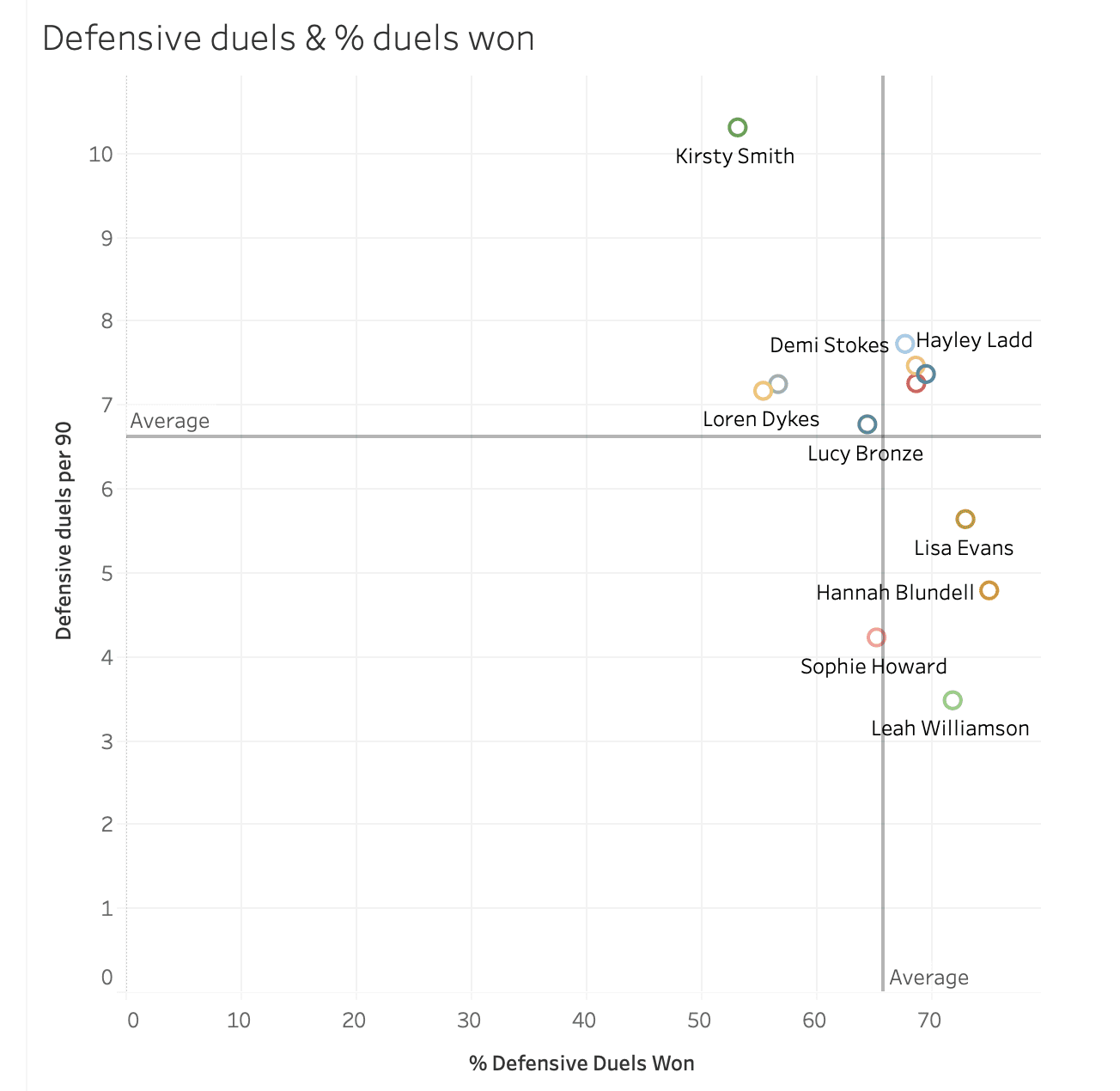
This initial overall comparison is between the number of defensive duels per 90 and the % of defensive duels won. Wyscout has defined a ‘defensive duel’ as one in which “the defender is playing 1v1 against the attacking player and trying to stop his/her attacking run or dribbling when the possession of the ball is in the other team”.
The scatter plot contains four quadrants, the top left contains players who have above average number of defensive duels per 90 minutes compared to the average of all twelve players but lower than average % of defensive duels won. This group includes Kirsty Smith, Loren Dykes, Rachel Daly, and Lucy Bronze. Lucy Bronze has especially close to the average statistics for both categories. The average number of defensive duels per 90 was 6.61, Lucy Bronze averages 6.76. The average % of defensive duels won was 65.76%, Lucy Bronze averages 64.42%.
The bottom left quadrant contains players who have below average numbers for both categories, Sophie Howard is the only player in this situation. The bottom right quadrant contains players who have below average number of defensive duels per 90, but above average % defensive duels won. This group of players contains Lisa Evans, Hannah Blundell, and Leah Williamson. The final quadrant, the top right, contains players who have above average in both the number of defensive duels per 90 and the % of defensive duels won. This group of players contains Demi Stokes, Hayley Ladd, Alex Greenwood, and Rachel Rowe. The player with the highest number of defensive duels per 90 was Kirsty Smith (10.3), whilst the player with the highest % of defensive duels won was Lisa Evans with (72.94%).
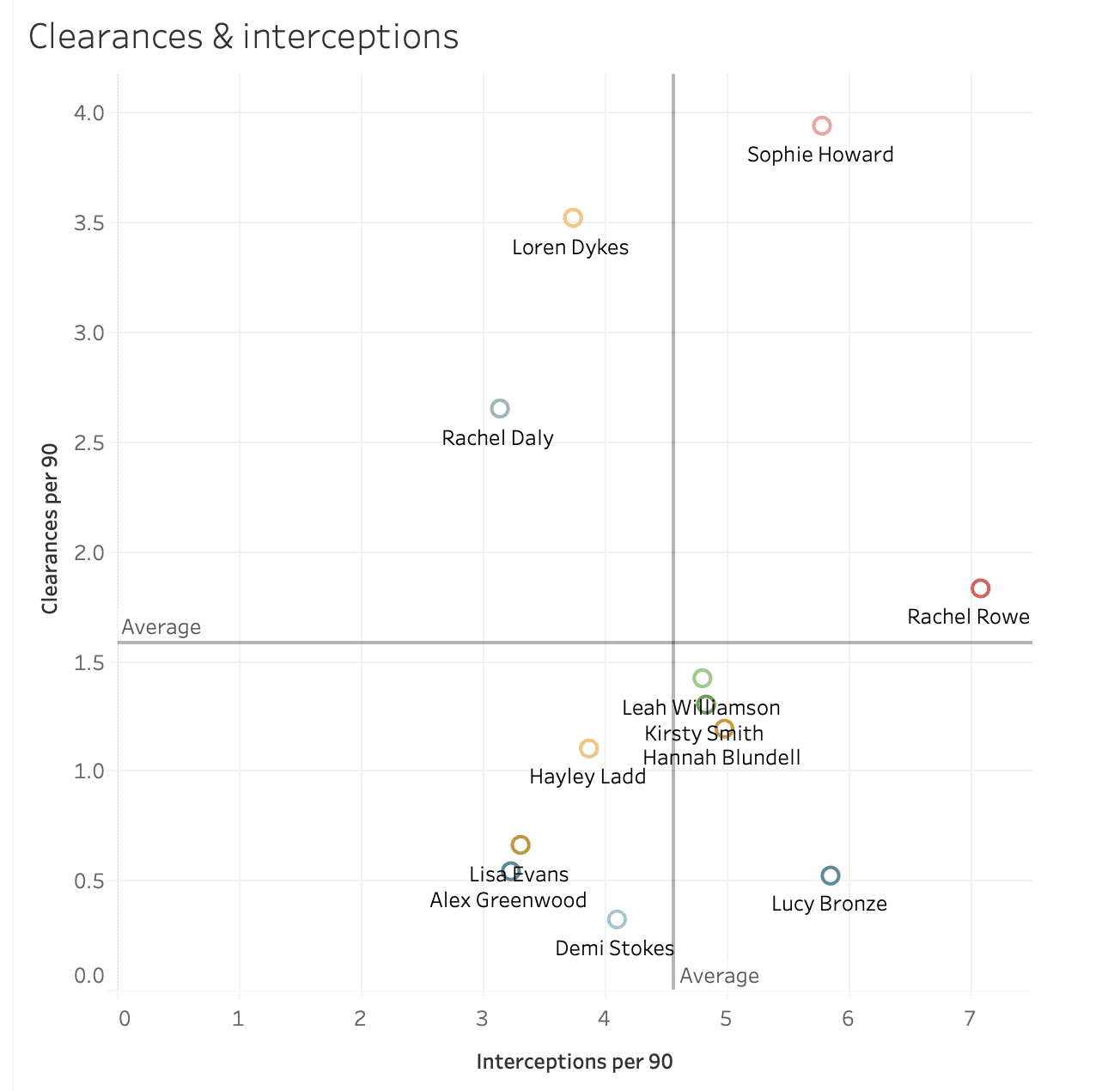
The second data comparison check is between the number of clearances per 90 and the number of interceptions per 90. Wyscout has defined an ‘interception’ as a metric used to describe “when a player is stopping the ball, intercepting it when the opponent is shooting, passing or crossing the ball”. Clearances are defined as a moment in the game “when a player is clearing the ball when he/she has no other options”.
The scatter plot demonstrates that Hayley Ladd, Lisa Evans, Alex Greenwood, and Demi Stokes have less than average in the number of interceptions and clearances per 90 minutes than the average of all twelve players. Sophie Howard and Rachel Rowe score above average in both categories. The player with the highest amount of interceptions per 90 minutes was Rachel Rowe (7.08) and clearances was Sophie Howard (3.94). The averages for each were 4.56 interceptions and 1.59 clearances per 90 minutes.
What must be accounted for and acknowledged during this stage of the analysis is that a team that have higher % of possession will potentially have players engaging in less defensive duels. Vice versa, those teams with a lower % possession will potentially have a higher frequency of defensive activity, thus players on these teams translating to a higher total number of defensive duels. For example, Olympique Lyonnais Feminin have a goal differential of +63 from 16 games and are clearly a dominant team within the Division 1 Feminine league. This would potentially impact the number of defensive actions of Lucy Bronze and Alex Greenwood.
In possession: ball progression
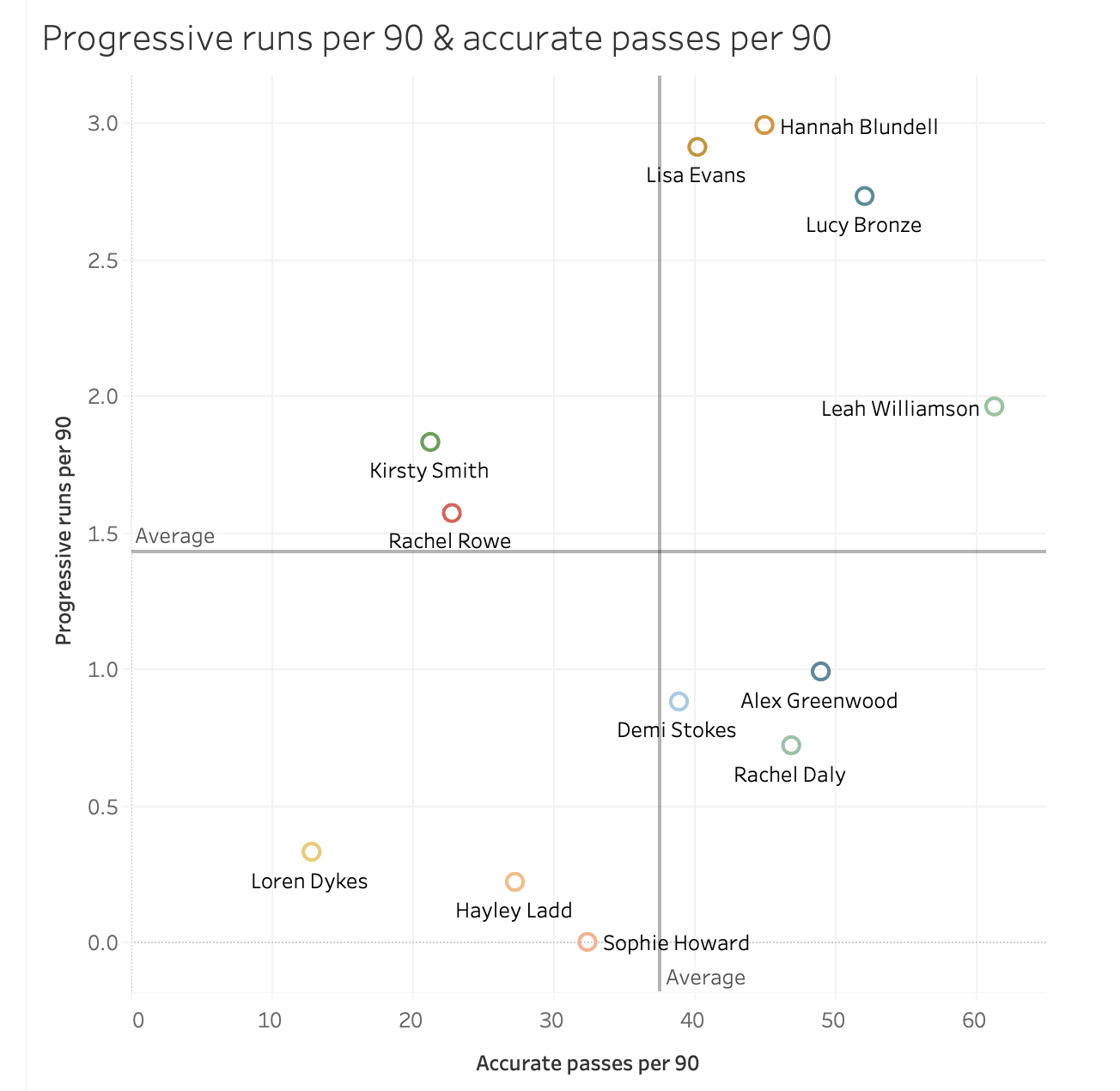
The second stage of the data analysis of potential wide defenders will look at the ability to maintain possession and progress the ball towards the opponent’s goal. The first comparison is between progressive runs per 90 and number of accurate passes per 90. A progressive run is either a run of 30m or more that starts in defensive half and ends in attacking half or a run of 10m or more that starts and ends in the attacking half.
From this scatter plot, Loren Dykes, Hayley Ladd, and Sophie Howard complete less average progressive runs and less number of accurate passes per 90 minutes. Whereas, Lisa Evans, Hannah Blundell, Lucy Bronze and Leah Williamson completer above the average in both categories. The highest scoring player in terms of the number of progressive runs was Hannah Blundell (2.99) and the player with the highest number of accurate passes per 90 minutes was Leah Williamson (61.32). The average for progressive runs was 1.43 and 37.51 for the number of accurate passes.
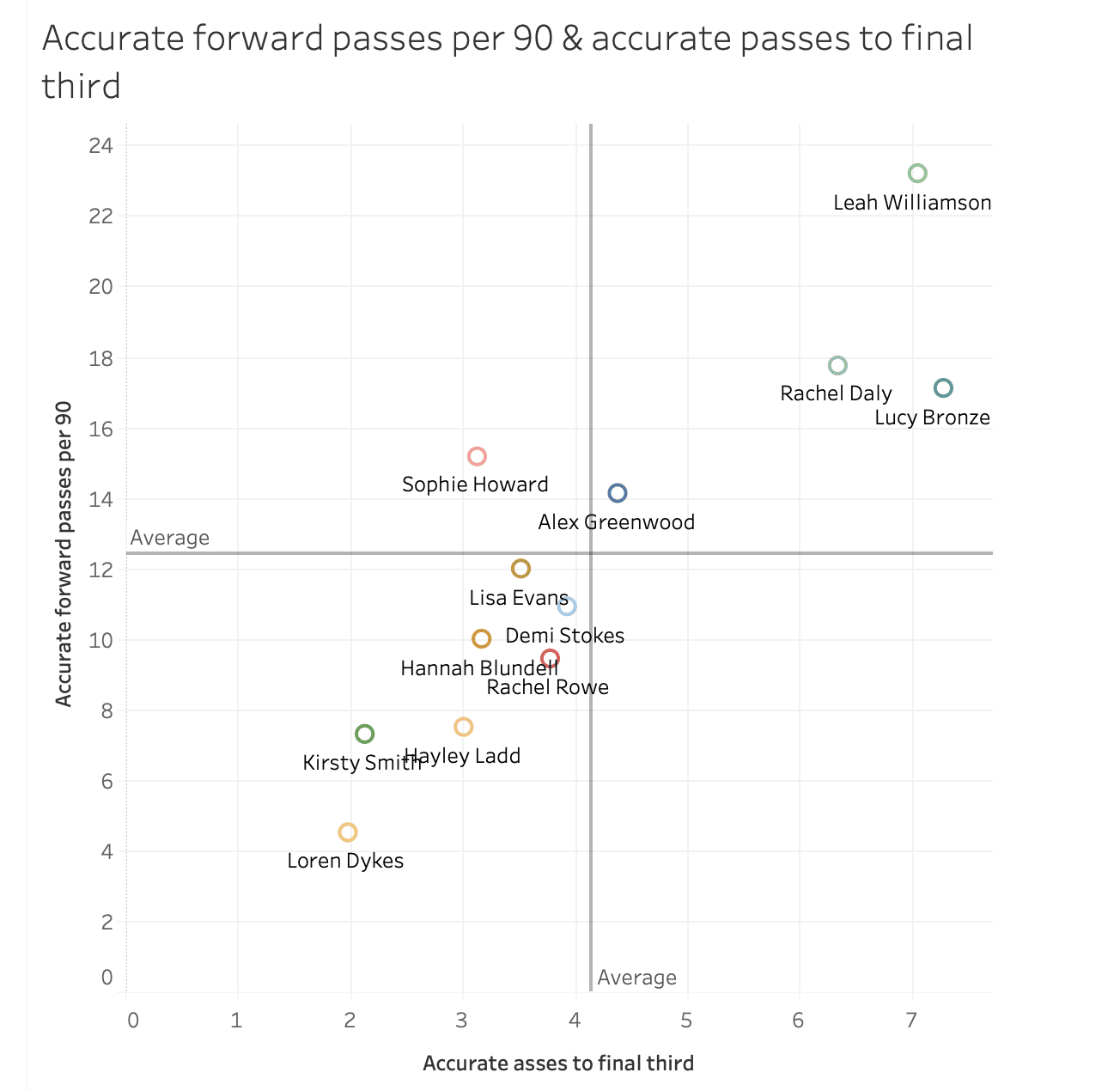
The second comparison utilized in identifying the wide defender’s ability to maintain possession and progress the ball will be a data check between the number of accurate forward passes per 90 and the number of passes to the final third. Lisa Evans, Demi Stokes, Hannah Blundell, Rachel Rowe, Hayley Ladd, Kirsty Smith, and Loren Dykes scored below the average on both categories whereas Alex Greenwood, Rachel Daly, Lucy Bronze, and Leah Williamson scored above the average in both. The highest scoring player in terms of number of accurate forward passes was Rachel Daly (17.75) and for passes to the final third, Lucy Bronze (7.28) came out on top. The averages were 12.42 accurate forward passes and 4.14 passes to the final third.
In possession: Impact in the final third
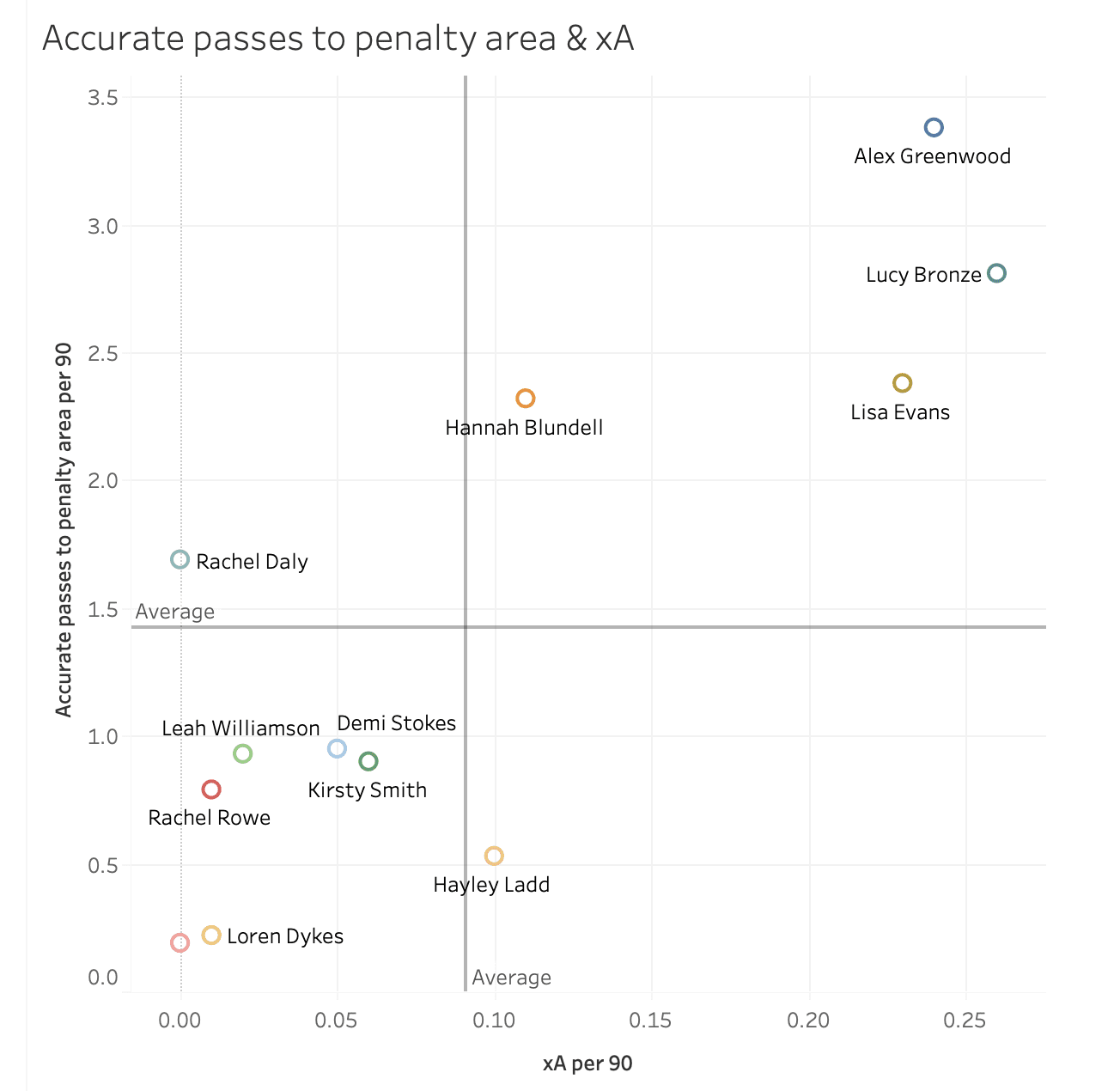
The final stage of the data analysis of potential wide defenders will look at the final third impact. The role of wide defenders in providing width, support and combination opportunities into the final third is becoming greater. With teams out of possession, either utilizing compact defensive strategies or tighter focused marking on the higher/attacking players, the wide defender is becoming an increasing and creative attacking option.
The comparison above has been made between the xA per 90 and number of passes to the penalty area per 90. xA refers to the expected assists, measuring the chance that a pass would result in a direct assist. Sophie Howard, Loren Dykes, Rachel Rowe, Leah Williamson, Demi Stokes, and Kirsty Smith scored below the average on both categories. Hannah Blundell, Lisa Evans, Lucy Bronze, and Alex Greenwood scored above the average. The highest scoring player in terms of accurate passes to the penalty area was Alex Greenwood (3.38), with the highest scoring xA belonging to Lucy Bronze (0.26). The average scores are 1.42 passes to the penalty area and 0.09 xA.
Conclusion
In conclusion this data analysis article, the third in the series has utilized specific metrics in order to identify three potential wide defenders. The analysis has looked at both out of possession and in possession statistics. By cumulating the total number of above average scores, Lucy Bronze and Alex Greenwood are the standout players for selection into the Team GB roster with Rachel Daly, Leah Williamson and Hannah Blundell in contention for the final roster spot. It must be noted finally that the data has been collected from multiple leagues with differing strengths of schedules. Video analysis must be combined with data analysis to provide further insight into the potential wide defenders.





Comments